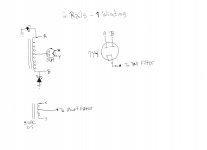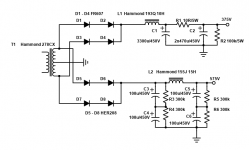Hello, I want to have two power supplies, one valve rectified with PIO caps and chokes for the driver stage of my SE amp.
And other supply with silicon diodes and electrolytic caps for the power tubes.
Can I just connect these two supplies in paralell to one power transformer winding?
Thank you very much for answer. Best regards, Michal
And other supply with silicon diodes and electrolytic caps for the power tubes.
Can I just connect these two supplies in paralell to one power transformer winding?
Thank you very much for answer. Best regards, Michal
A full wave bridge and full wave center tap off the same winding is possible, with the bridge giving 2X the voltage. It’s just a standard split supply with the negative rail called “ground”. Works great with sweep tubes because you need the 1/2 B+ for the screens. Or if you run a “stupid high” B+ for transmitting tubes and want something lower available for everything else without wasting 50 watts in resistors and needing all the electrolytics to handle the full B+ for the start up surge.
Some time ago, an idea for using 5 diodes to obtain 2 rails, 1 "tall" and 1 "short", from a single CT winding was presented. I'm providing an illustration of the technique.
The "tall" rail is bridge rectified and the "short" rail is FWCT. The OP can have what is desired by using 4X SS diodes and 1 vacuum rectifier.
The "tall" rail is bridge rectified and the "short" rail is FWCT. The OP can have what is desired by using 4X SS diodes and 1 vacuum rectifier.
Attachments
The famous "Objective 2 Headphone Amplifier" (sometimes abbreviated O2) creates two DC power supplies from only one, not-center-tapped, transformer secondary winding. The circuit schematics are online and can be freely downloaded. Google is your friend.
In this particular case, the designer has chosen to use one single wall-wart, to provide both +15VDC and -15VDC outputs. The wall wart is an AC output device. That means at the end of the wall wart cable, the two pins on the barral jack are directly connected to the transformer secondary's pins. It's an AC-to-AC wall wart, whereas most wall warts are AC-to-DC.
But for the purposes of the original question in post #1 of this discussion thread, "AC-to-AC wall wart" means "a transformer with one secondary winding, and the secondary winding has two terminals not three"
_
In this particular case, the designer has chosen to use one single wall-wart, to provide both +15VDC and -15VDC outputs. The wall wart is an AC output device. That means at the end of the wall wart cable, the two pins on the barral jack are directly connected to the transformer secondary's pins. It's an AC-to-AC wall wart, whereas most wall warts are AC-to-DC.
But for the purposes of the original question in post #1 of this discussion thread, "AC-to-AC wall wart" means "a transformer with one secondary winding, and the secondary winding has two terminals not three"
_
Last edited:
If you want to connect two supplies to a common power transformer that has a grounded CT, and the first element (closest to the transformer) in each supply is a diode (tube or silicon) it will probably work as intended. Draw up a simple sketch and post it here if you want to know for sure.
Two different HT voltages that are roughly a 2:1 as needed for screen grids in sweep tubes are possible, but that doesn't seem to be what the OP is after. He seems to want a clean tube, choke and PIO supply for the low level stages, and a brute force big electro and silicon diode supply for the power amp. That's possible too as long as the diodes isolate the input caps from each other.
Here's my take on some unnecessarily complex power supplies for low buck guitar amps. One $16 isolation transformer supplies rectified, but unfiltered DC for the series string tube heaters, and clean FWB rectified and filtered 170 volts for B+
Its bigger brother uses a bigger 80 VA isolation transformer to get 165 VDC for the tube heaters, and output stage screen grids, and full wave voltage doubled 340 volts for the tube plates. That amp runs 45B5 / UL84's (a 45 volt 100 mA 6CW5) for 20 watts of power output. Input tubes are 26AQ6 / UCC85.
Lots of parts, but diodes and caps are far cheaper than transformers. The 100 mA series string tubes are also far cheaper than their 6 volt siblings.
Two different HT voltages that are roughly a 2:1 as needed for screen grids in sweep tubes are possible, but that doesn't seem to be what the OP is after. He seems to want a clean tube, choke and PIO supply for the low level stages, and a brute force big electro and silicon diode supply for the power amp. That's possible too as long as the diodes isolate the input caps from each other.
Here's my take on some unnecessarily complex power supplies for low buck guitar amps. One $16 isolation transformer supplies rectified, but unfiltered DC for the series string tube heaters, and clean FWB rectified and filtered 170 volts for B+
Its bigger brother uses a bigger 80 VA isolation transformer to get 165 VDC for the tube heaters, and output stage screen grids, and full wave voltage doubled 340 volts for the tube plates. That amp runs 45B5 / UL84's (a 45 volt 100 mA 6CW5) for 20 watts of power output. Input tubes are 26AQ6 / UCC85.
Lots of parts, but diodes and caps are far cheaper than transformers. The 100 mA series string tubes are also far cheaper than their 6 volt siblings.
Attachments
- Status
- This old topic is closed. If you want to reopen this topic, contact a moderator using the "Report Post" button.
- Home
- Amplifiers
- Tubes / Valves
- Two power supplies with one transformer winding

